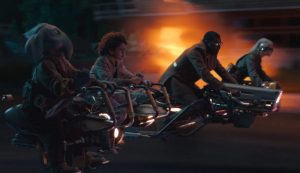High Republic: ecco in anteprima il primo capitolo del romanzo Light of the Jedi!

Copertina del romanzo "Light of the Jedi". Da: CW Las Vegas
A Gennaio 2021 saranno finalmente rilasciate le prime storie riguardanti la High Republic, e cioè le vicende ambientate 200 anni prima di Episodio I. Capostipite di questa nuova era sarà il romanzo Light of the Jedi, scritto dal mitico Charles Soule. Poco più di un’ora fa è trapelato in esclusiva il primo capitolo del romanzo, che ci rivela l’evento catastrofico che ha colpito la galassia. Vediamolo insieme!
Le parole di Soule
Come rivela l’anteprima di Light of the Jedi (che trovate in basso), è la distruzione apparentemente accidentale di una grande astronave che viaggia nell’iperspazio la calamità di cui si parlava in questi mesi. In The Last Jedi, la manovra Holdo ci ha mostrato quanto possa essere pericolosa una nave che si muove a velocità iperspaziale, ma il modo in cui Soule descrive ciò che accade nella sua storia rende il tutto notevolmente peggiore.
“Questo estratto è il primo sguardo al momento esatto che cambia per sempre l’Alta Repubblica”, ha detto Soule a IGN. “La distruzione della Legacy Run (l’astronave) è il catalizzatore di un disastro di proporzioni galattiche. Frammenti della nave mercantile distrutta iniziano a volare fuori dall’iperspazio a velocità super-accelerate, il che significa che missili mortali di detriti possono apparire ovunque in qualsiasi momento, dall’orlo esterno al nucleo. In questo momento di crisi, la Repubblica si rivolge ai guardiani della pace e della giustizia, i Jedi.”
Soule ha continuato: “Le battute iniziali di Light of the Jedi descrivono un disastro epico e una risposta eroica ed elettrizzante sia dalla Repubblica che dagli Jedi per salvare vite umane e porre fine alla crisi. È solo l’inizio, però. Il disastro della Legacy Run dà il via a una storia molto più ampia; è davvero solo un pezzo di una saga molto più grande. ” Trovate il primo capitolo del romanzo qui in basso: fermatevi se non volete spoiler!
STAR WARS: THE HIGH REPUBLIC – LIGHT OF THE JEDI
By Charles Soule

The Force is with the galaxy.
It is the time of The High Republic: a peaceful union of like-minded worlds where all voices are heard, and governance is achieved through consensus, not coercion or fear. It is a time of ambition, of culture, of inclusion, of Great Works. Visionary Chancellor Lina Soh leads the Republic from the elegant cityworld of Coruscant, located near the bright center of the Galactic Core.
But beyond the Core and its many peaceful Colonies, there is the Rim—Inner, Mid, and finally, at the border of what is known: The Outer Rim. These worlds are filled with opportunity for those brave enough to travel the few well-mapped hyperspace lanes leading to them, though there is danger as well. The Outer Rim is a haven for anyone seeking to escape the laws of the Republic, and is filled with predators of every type.
Chancellor Soh has pledged to bring the Outer Rim worlds into the embrace of the Republic through ambitious outreach programs such as the Starlight Beacon. Order and justice are maintained on the galactic frontier by Jedi Knights, guardians of peace who have mastered incredible abilities stemming from a mysterious energy field known as the Force. The Jedi work closely with the Republic, and have agreed to establish outposts in the Outer Rim to help any who might require aid.
The Jedi of the frontier can be the only resource for people with nowhere else to turn. Though the outposts operate independently and without direct assistance from the great Jedi temple on Coruscant, they act as an effective deterrent to those who would do evil in the dark.
Few can stand against the Knights of the Jedi Order.
But there are always those who will try….
CHAPTER ONE
HYPERSPACE. THE LEGACY RUN.
3 HOURS TO IMPACT.
All is well.
Captain Hedda Casset reviewed the readouts and displays built into her command chair for the second time. She always went over them at least twice. She had more than four decades of flying behind her, and figured the double-check was a large part of the reason she was still flying. The second look confirmed everything she’d seen in the first.
“All is well,” she said, out loud this time, announcing it to her bridge crew. “Time for my rounds. Lieutenant Bowman, you have the bridge.”
“Acknowledged, captain,” her first officer replied, standing from his own seat in preparation to occupy hers until she returned from her evening constitutional.
Not every long-haul freighter captain ran their ship like a military vessel. Hedda had seen starships with stained floors and leaking pipes and cracks in their cockpit windows, lapses that speared her to her very soul. But Hedda Casset began her career as a fighter pilot with the Malastare-Sullust Joint Task Force, keeping order in their little sector of the Mid-Rim. She’d started out flying an Incom Z-24, the single-seat fighter everyone just called a Buzzbug. Mostly police action missions, hunting down pirates and the like. Eventually, though, she rose to command a heavy cruiser, one of the largest vessels in the fleet. A good career, doing good work.
She’d left Mallust JTF with distinction, moved on to a job captaining merchant vessels for the Byrne Guild—her version of a relaxed retirement. But thirty-plus years in the military meant order and discipline weren’t just in her blood—they were her blood. So, every ship she flew now was run like it was about to fight a decisive battle against a Hutt Armada, even if it was just carrying a load of ogrut hides from world A to world B. This ship, the Legacy Run, was no exception.
Hedda stood, accepting and returning Lieutenant Jary Bowman’s snapped salute. She stretched, feeling the bones of her spine crackle and crunch. Too many years on patrol in tiny cockpits, too many high-G maneuvers—sometimes in combat, sometimes just because it made her feel alive.
The real problem, though, she thought, tucking a stray strand of gray hair behind one ear, is too many years.
She left the bridge, departing the precise machine of her command deck and walking along a compact corridor into the larger, more chaotic world of the Legacy Run. The ship was a Kaniff Yards Class-A Modular Freight Transport, almost as old as she was. That put the craft a bit past her ideal operational life, but well within safe parameters if she was well-maintained and regularly serviced—which she was. Her captain saw to that.
The Run was a mixed-use ship, rated for both cargo and passengers—hence “modular” in its designation. It was composed of a huge central compartment, shaped like a long, triangular prism, with engineering aft and the rest of the space allotted for cargo. The bridge connected to the central hull via long boom arms, one of which she was traversing at that very moment. Additional smaller modules could be attached to the central section, up to a hundred and forty-four, swapped in and out at the yard depending on what was needed for a given run.
Hedda liked the ship’s variable qualities, because it meant you never knew what you were going to get, what weird challenges you might face from one job to the next. She had flown the ship once when half its cargo allotment was reconfigured into a huge water tank, to carry a gigantic saberfish from the storm seas on Spira to the private aquarium of a countess on Abregado. Hedda and her crew had gotten the beast there safely—not an easy gig. Even harder, though, was getting the creature back to Spira three cycles later, when the blasted thing got sick because the countess’ people had no idea how to take care of it. She gave the woman credit, though—she paid full freight to send the saberfish home. A lot of people, nobles especially, would have just let it die.
This particular trip, in comparison, was as simple as they came. The Legacy Run’s cargo sections were about eighty percent filled with settlers heading to the Outer Rim from overpopulated Core and Colonies worlds, seeking new lives, new opportunities, new skies. She could relate to that. Hedda Casset had been restless all her life. She had a feeling she’d die that way too, looking out a viewport, hoping her eyes would land on something she’d never seen before.
Because this was a transport run, most of the ship’s modules were basic passenger configurations, with open seating that converted into beds that were, in theory, comfortable enough to sleep in. Sanitary facilities, storage, a few holoscreens, small galleys, and that was it. For settlers willing to pay for the increased comfort and convenience, some had droid-operated auto-canteens and private sleeping compartments, but not many. These people were frugal. If they had money to begin with, they probably wouldn’t be heading to the Outer Rim to try to scrape out a future. The dark edge of the galaxy was a place of challenges both exciting and deadly. More deadly than exciting, in truth.
Even the road to get out here is tricky, Hedda thought, her gaze drawn by the swirl of hyperspace outside the large porthole she happened to be passing. She snapped her eyes away, knowing she could end up standing there for twenty minutes if she let herself get sucked in. You couldn’t trust hyperspace. It was useful, sure, it got you from here to there, it was the key to the expansion of the Republic out from the Core, but no one really understood it. If your navidroid miscalculated the coordinates, even a little, you could end up off the marked route, the main road through whatever hyperspace actually was, and then you’d be on a dark path leading to who knew where. It happened even in the well-traveled hyperlanes near the galactic center, and out here, where the prospectors had barely mapped out any routes…well, it was something you had to keep an eye on.
She put it out of her mind and continued on her way. The truth was, the Legacy Run was currently speeding along the most well-traveled, well-known route to the Rim worlds. This was a milk run. Ships moved along this hyperlane constantly, in both directions. Nothing to worry about.
But more than nine thousand souls aboard this ship were depending on Captain Hedda Casset to get them safely to their destination. She worried.
Hedda exited the corridor and entered the central hull, emerging in a large, circular space, an open spot necessitated by the ship’s structure that had been repurposed as a sort of unofficial common area. A group of children kicked a ball around, as adults stood and chatted nearby, or just stretched out in a zone that was different than the zone in which they awakened every morning. The space wasn’t fancy, just a bare junction spot where several short corridors met—but it was clean. The ship employed—at its captain’s insistence—an automated maintenance crew that kept its interiors neat and sanitary. One of the custodiodroids was spidering its way along a wall at that very moment, performing one of the endless tasks required on a ship the size of the Run.
She took a moment to take stock of this group—twenty people or so, all ages, from a number of worlds. Humans, of course, but also a few scale-skinned Trandoshans, a family of Bith and even an Ortolan, blue skin and long snout and the big, ponderous flaps protruding from the side of its head—you didn’t see many of those around. But no matter their planet of origin, they were all just ordinary people, biding time until their new lives could begin.
One of the kids looked up.
“Captain Casset!” the boy said, a human, olive-skinned with red hair. She knew him.
“Hello, Serj,” Hedda said. “What’s the good word? Everything all right here?”
The other children stopped their game and clustered around her.
“Could use some new holos,” Serj said. “We’ve watched everything in the system.”
“All we got is all we got,” Hedda replied. “And stop trying to chip into the archive to see the age-restricted titles. You think I don’t know? This is my ship. I know everything that happens on the Legacy Run.”
She learned forward.
“Everything.”
Serj blushed and looked toward his friends, who had also, suddenly, found very interesting things to look at on the absolutely uninteresting floor, ceiling and walls of the chamber.
“Don’t worry about it,” she said, straightening. “I get it. This is a pretty boring ride. You won’t believe me, but in not too long, when your parents have you plowing fields or building fences or fighting off rancors you’ll be dreaming of the time you spent on this ship. Just relax and enjoy.”
Serj rolled his eyes and returned to whatever improvised ball game he and the other kids had devised.
Hedda grinned and moved through the room, nodding and chatting as she went. People. Probably some good, some bad, but for the next few days, her people. She loved these runs. No matter what eventually happened in the lives of these folks, they were heading to the Rim to make their dreams come true. She was part of that, and it made her feel good.
Chancellor Soh’s Republic wasn’t perfect—no government was or ever could be—but it was a system that gave people room to dream. No, even better. It encouraged dreams, big and small. The Republic had its flaws, but all things considered, it could be a hell of a lot worse.
Hedda’s rounds took over an hour—she made her way through the passenger compartments, but also checked on a shipment of supercooled liquid tibanna to make sure the volatile stuff was properly locked down (it was), inspected the engines (all good), investigated the status of repairs to the ship’s environmental recirculation systems (in progress and proceeding nicely) and made sure fuel reserves were still more than adequate for the rest of the journey with a comfortable margin besides (they were.)
The Legacy Run was exactly as she wanted it to be. A tiny, well-maintained world in the wilderness, a warm bubble of safety holding back the void. She couldn’t vouch for what was waiting for these settlers once they dispersed into the Outer Rim, but she would make sure they got there safe and sound to find out.
Hedda returned to the bridge, where Lieutenant Bowman all but leapt to his feet the moment he saw her enter.
“Captain on the bridge,” he said, and the other officers sat up straighter.
“Thank you, Jary,” Hedda said, as her second stepped aside and returned to his post.
Hedda settled in to her command chair, automatically checking the displays, scanning for anything out of the ordinary.
All is well, she thought.
KTANG. KTANG. KTANG. KTANG.
An alarm, loud and insistent. The bridge lighting flipped into its emergency configuration—bathing everything in red. Through the front port, the swirls of hyperspace looked off, somehow. Maybe it was the emergency lighting, but they had a…reddish tinge. It looked…sickly.
Hedda felt her pulse quicken. Her mind snapped into combat mode without thinking.
“Report!” she barked out, her eyes whipping along her own set of screens to find the source of the alarm.
“Alarm generated by the navicomp, captain,” called out her navigator, Cadet Kalwar, a young Quermian. “There’s something in the hyperlane. Dead ahead. Big. Impact in ten seconds.”
The cadet’s voice held steady, and Hedda was proud of him. He probably wasn’t that much older than Serj.
She knew this situation was impossible. The lanes were selected because they were free of potential debris, their clarity calculated down to a meter of resolution. Any granules missed would be detected and evaded by the shipboard navidroids making adjustments along the vector. Lightspeed collisions along established lanes were mathematical absurdities.
She also knew that even though it was impossible, it was happening, and that ten seconds was no time at all at speeds like the Legacy Run was traveling.
You can’t trust hyperspace, she thought.
Hedda Casset tapped two buttons on her command console.
“Brace yourselves,” she said, her voice calm. “I’m taking control.”
Two piloting sticks snapped up out from the armrests of her captain’s chair, and Hedda grasped them, one in each hand.
She spared herself the time for one breath, and then she flew.
The Legacy Run was not an Incom Z-24 Buzzbug, or even one of the new Republic Longbeams. It was a sixty-year-old freighter at the end of—if not beyond—its operational lifespan, loaded to capacity, with engines designed for slow, gradual acceleration and deceleration, and docking with spaceports and orbital loading facilities. It maneuvered like a moon.
The Legacy Run was no warship. Not even close. But Hedda flew it like one.
She saw the obstacle in their path with her fighter pilot’s eye and instincts, saw it advancing at incredible velocity, large enough that both her ship and whatever it was would be disintegrated into atoms, dust drifting forever through the hyperlanes. There was no time to avoid it. The ship could not make the turn. There was no room, and there was no time.
But Captain Hedda Casset was at the helm, and she would not fail her ship.
The tiniest tweak of the left control stick, and a larger rotation of the right, and the Legacy Run moved. More than it wanted to, but not less than she believed it could, and the huge freighter slipped past the obstacle in their path, the thing shooting past their hull so close Hedda was sure she felt its passing ruffle her hair despite the many layers of metal and shielding between them.
But they were alive. No impact. The ship was alive.
Turbulence, and Hedda fought it, feeling her way through the jagged bumps and ripples, closing her eyes, not needing to see to fly. The ship groaned, its frame complaining.
“You can do it, old gal,” she said, out loud. “We’re a couple of cranky old ladies and that’s for sure, but we’ve both got a lot of life to live. I’ve taken damn good care of you, and you know it. I won’t let you down if you won’t let me down.”
Hedda did not fail her ship.
It failed her.
The groan of overstressed metal became a scream. The vibrations of the ship’s passage through space took on a new timbre Hedda had felt too many times before. It was the feeling of a ship that had moved beyond its limits, whether from taking too much damage in a firefight or, as here, just being asked to perform a maneuver that was more than it could give.
The Legacy Run was tearing itself apart. It had seconds to live, at most.
Hedda opened her eyes. She released the control sticks and tapped out commands on her console, activating the bulkhead shielding that separated each cargo module in the instance of a disaster, thinking that perhaps it might give some of the people aboard a chance. She thought about Serj and his friends, playing in the common area, and how emergency doors had just slammed down at the entrance to each passenger module, possibly trapping them in a zone that was shortly about to become vacuum. She hoped the children had gone to their families when the alarms sounded.
She didn’t know.
She just didn’t know.
Hedda locked eyes with her first officer, who was staring at her, knowing what was about to happen. He saluted.
“Captain,” Lieutenant Bowman said, “it’s been an—”
The bridge ripped open.
Hedda Casset died, not knowing if she had saved anyone at all.



